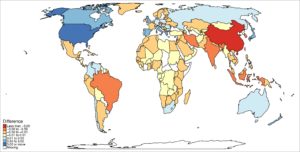These days, most online journals are effectively international, having readers around the world and accepting submissions for any researcher, anywhere. But

how international and geographically diverse are journal editorial boards, especially compared to thegeographic diversity of the authors publishing in those journals?
In the article based on their award-winning abstract from the recent CSE 2019 Annual Meeting, Cultural and Geographical Representation in the Editorial Boards of Aquatic Science Journals, Rafael Araújo and Geoffrey Shideler examined this issue. What they found is that for aquatic science journals some countries, particularly the US, have an over-representation on editorial boards whereas others, particularly China, are underrepresented compared to how often authors from those countries publish in the journal.
The authors refer to this difference as either an editorial surplus or deficit and provide a framework for determining where your journal stands: take the geographic representation of your editors (eg, 50% US-based editors, 20% Canada, 10% Japan) and compare it to the country of origin for published articles in your journal. For example, you may find that 60% of your editors are based at US institutions, but only 40% of the articles you publish in a year originate in the US. I highly suspect that the findings they show in Figure 1 for aquatic journals, that is, a surplus for US, Canada, and most of Europe, and a deficit for most of the rest of the world, is fairly common.
Importantly, Araújo and Shideler also find a relationship between the geographic diversity of journal editors and Scimago journal rank, as journals with more diverse editorial boards tended to be ranked higher. While causation can’t be determined (for example, higher ranked journals may have an easier time recruiting international editors), they did find that geographically diverse journals were rarely low-ranked. This implies a likely virtuous cycle, wherein international editors help attract the best research from around the world, helping to attract more top international editors, and onwards and upwards.
But geographic diversity doesn’t happen on its own, and as the authors show, there are still quite a few glaring editorial deficits that trends indicate will likely continue to grow, especially when it comes to China. How journals address these deficits will be an important part of the coming decade.
-Jonathan Schultz
Editor-in-Chief, Science Editor
Recent Early Online Article
The Summer 2019 issue was pushed back a bit, but in the meantime, please enjoy a preview of the issue in the form of my recently posted Viewpoint: Memories Regained: On Opening up Peer Review. Look for the Summer 2019 issue online within the next week and in your mailboxes soon thereafter.
Hot Articles from Recent Issues (For CSE Members only)
As a CSE member benefit, once Science Editor articles are moved to an issue, they are available only to CSE Members for one year.
In my discussions with editors regarding ethical concerns, I often think of this article from last Fall by Nancy Gough, My Words or Your Words? Detecting and Investigating Plagiarism. As we are all busy, editors love tools that work automatically with little need for manual review to check things like plagiarism. And while software has come a long way, as Nancy points out, plagiarism can be a complicated issue that needs a thoughtful editor to parse out what is a mistake, acceptable reuse, or something more problematic. Recently on social media, authors have been complaining about journals rejecting submissions based on the results of the automated plagiarism review even though the overlap is from a preprint posting, which don’t violate the journals’ policies, and a thoughtful editor should have noticed.
Not a CSE member? Additional membership info along with instructions for becoming a member of the Council of Science Editors can be found here.
Resource of the Month
Being an editor and working at scientific publication requires being ever knowledgeable of a rapidly changing scientific and publishing landscape, so each month we highlight a resource that will hopefully make this at least a little bit easier.
Have you checked out the recently revamped Council of Science Editors homepage and the new Student Resources section? Even if you’re not a student, the new section provides a wealth of helpful info and resources for gaining experience, understanding scientific publishing, and much more.
For the Road
Last week I was at a conference focused on basic science, and an early career blogger covering the sessions noted that many were tricky to report on as speakers presented a bewildering array of acronyms and arcane scientific terms that even experts may struggle with. This problem is exacerbated for deaf attendees and the conferences that try to support them, or as this BBC News headline put it, What’s deoxyribonucleotide in sign language?
As deaf student Liam Mcmulkin discovered, the traditional approach to handling a non-standard term in sign language is to spell out each letter, which has to result in some sprained wrists when discussing, say, gene expression. So Liam decided to tackle the problem, and as a result, There Are Now 100 New Sign Language Terms for Scientific Words Thanks to This Deaf Student. Hopefully, this will make conferences more accessible going forward. (hat tip to new Editorial Board member, Becky Rivard)
Feedback and suggestions are always welcome at scienceeditor@councilscienceeditors.org.
We are also always looking for new submissions or article suggestions you may have; for more details, see our Information for Authors.
